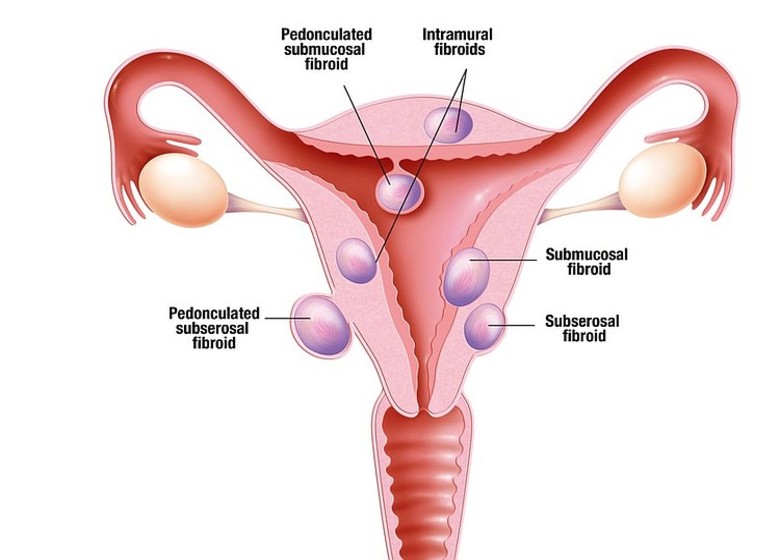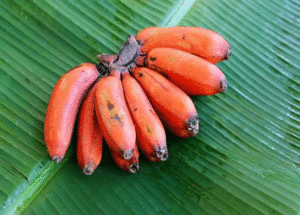Fibroids: Types, Causes and Symptoms
Uterine fibroids are noncancerous growths of the uterus that often appear during childbearing years. Also called leiomyomas (lie-o-my-O-muhs) or myomas, uterine fibroids aren’t associated with an increased risk of uterine cancer and almost never develop into cancer.
Fibroids range in size from seedlings, undetectable by the human eye, to bulky masses that can distort and enlarge the uterus. You can have a single fibroid or multiple ones. In extreme cases, multiple fibroids can expand the uterus so much that it reaches the rib cage.
Many women have uterine fibroids sometime during their lives. But most women don’t know they have uterine fibroids because they often cause no symptoms. Your doctor may discover fibroids incidentally during a pelvic exam or prenatal ultrasound.
Who is at risk for fibroids?
Women are at greater risk for developing fibroids if they have one or more of the following risk factors:
- pregnancy
- a family history of fibroids
- age of 30 or older
- African-American
- a high body weight
Symptoms
Around 1 in 3 women with fibroids will experience symptoms.
These may include:
- heavy, painful periods, also known as menorrhagia
- anemia from heavy periods
- lower backache or leg pain
- constipation
- discomfort in the lower abdomen, especially in the case of large fibroids
- frequent urination
- pain during intercourse, known as dyspareunia
Other possible symptoms include:
- labor problems
- pregnancy problems
- fertility problems
- repeated miscarriages
If fibroids are large, there may also be weight gain and swelling in the lower abdomen.
Once a fibroid develops, it can continue to grow until menopause As estrogen levels fall after menopause, the fibroid will usually shrink.
Causes
Doctors don’t know the cause of uterine fibroids, but research and clinical experience point to these factors:
- Genetic changes.Many fibroids contain changes in genes that differ from those in normal uterine muscle cells.
- Estrogen and progesterone, two hormones that stimulate development of the uterine lining during each menstrual cycle in preparation for pregnancy, appear to promote the growth of fibroids. Fibroids contain more estrogen and progesterone receptors than normal uterine muscle cells do. Fibroids tend to shrink after menopause due to a decrease in hormone production.
- Other growth factors.Substances that help the body maintain tissues, such as insulin-like growth factor, may affect fibroid growth.
Doctors believe that uterine fibroids develop from a stem cell in the smooth muscular tissue of the uterus (myometrium). A single cell divides repeatedly, eventually creating a firm, rubbery mass distinct from nearby tissue.
The growth patterns of uterine fibroids vary — they may grow slowly or rapidly, or they may remain the same size. Some fibroids go through growth spurts, and some may shrink on their own. Many fibroids that have been present during pregnancy shrink or disappear after pregnancy, as the uterus goes back to a normal size.
What are the different types of fibroids?
The type of fibroid a woman develops depends on its location in or on the uterus.
Intramural fibroids
Intramural fibroids are the most common type of fibroid. These types appear within the muscular wall of the uterus. Intramural fibroids may grow larger and can stretch your womb.
Subserosal fibroids
Subserosal fibroids form on the outside of your uterus, which is called the serosa. They may grow large enough to make your womb appear bigger on one side.
Pedunculated fibroids
Subserosal tumors can develop a stem, a slender base that supports the tumor. When they do, they’re known as pedunculated fibroids.
Submucosal fibroids
These types of tumors develop in the middle muscle layer, or myometrium, of your uterus. Submucosal tumors aren’t as common as the other types.
Diagnosis
As fibroids often do not show symptoms, they are usually diagnosed during routine pelvic examinations.
The following diagnostic tests can detect fibroids and rule out other conditions:
- A doctor can create ultrasound images by scanning over the abdomen or by inserting a small ultrasound probe into the vagina. Both approaches may be needed.
- An MRI can determine the size and quantity of fibroids.
- A hysteroscopy uses a small device with a camera attached to the end to examine the inside of the womb. The device is inserted through the vagina and into the womb through the cervix. If necessary, the doctor can take a biopsy at the same time to identify potentially cancerous cells in the area.
- A laparoscopy may also be performed. In a laparoscopy, the doctor makes a small opening in the skin of the abdomen and inserts a small tube with a lighted camera attached through the layers of abdominal wall. The camera reaches into the abdominopelvic cavity to examine the outside of the womb and its surrounding structures. If necessary, a biopsy can be taken from the outer layer of the womb.
Complications
- Pregnancy problems: Fibroids usually don’t interfere with getting pregnant. However, it’s possible that fibroids — especially submucosal fibroids — could cause infertility or pregnancy loss. Fibroids may also raise the risk of certain pregnancy complications, such as placental abruption, fetal growth restriction and preterm delivery.
- Infertility: In some cases, fibroids can make it harder for the fertilized egg to attach itself to the lining of the womb. A submucosal fibroid growing on the inside of the uterine cavity may change the shape of the womb, making conception more difficult.
- Leiomyosarcoma: This is a rare form of cancer that is thought by some to be able to develop inside of a fibroid in very rare cases.
A woman with fibroids who suddenly develops severe abdominal pain should contact her doctor immediately.
Your prognosis will depend on the size and location of your fibroids. Fibroids may not need treatment if they’re small or don’t produce symptoms.
By making healthy lifestyle choices, such as maintaining a normal weight and eating fruits and vegetables, you may be able to decrease your fibroid risk.
Also read: Ovarian Cyst: Symptoms, Types and causes













